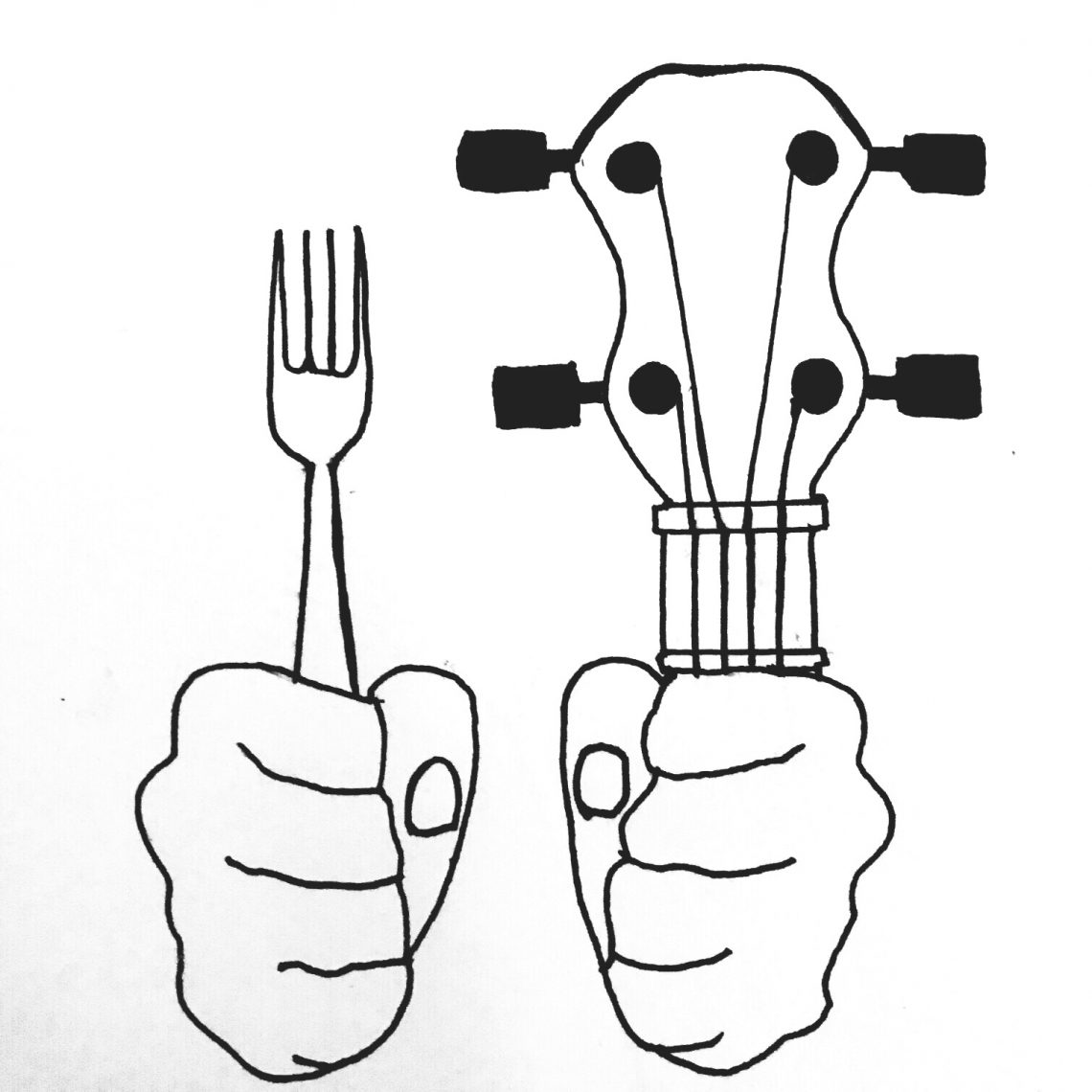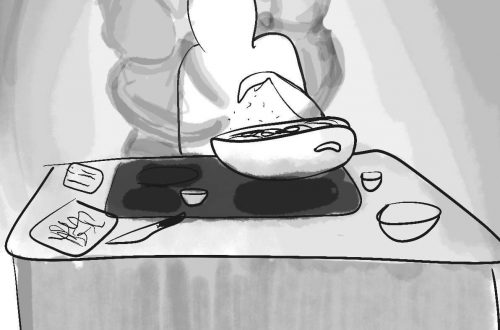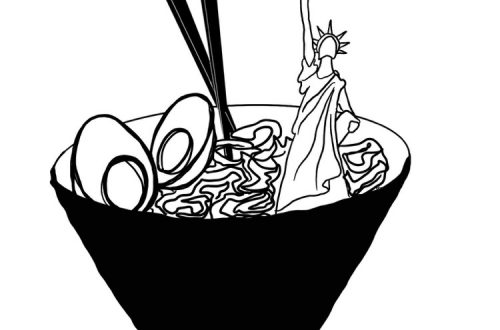by Luisa Kay Reyes
Art by Corinne Pease
Luisa’s essay, “Dinner on the Grounds,” appears in Episode 7 of The Dirty Spoon Radio Hour, which aired on November 2, 2018.
The pastel colored tablecloths are carefully laid out over the tables. Each aging family matriach, with the help of someone younger, sets out her array of homemade dishes. The matriarchs and their families have traveled a long way, through national forests, over rough dirt roads, with food contained in large cardboard boxes to keep spills off the backseat. It is time for a waning tradition: all-day singing and dinner on the grounds.
Members of our younger generation might be tempted to avoid waking up early on Sunday morning to prepare enough food for a small army, but it is an unspoken agreement that a quick pit-stop at some Wal-Mart to grab prepared fried chicken before the rural country church singings is…flat-out cheating. No sensible person will honor any store-bought contribution when there is a splendid array of homemade green beans, lima beans, and black-eyed peas.
This is, after all, as deep of a Southern tradition as it gets. The all day singings and dinner on the grounds throughout Bibb County in rural Alabama are replete with the country dishes that are often the big draw of the day. Certain family members are known for their chicken and dumplings, while others are known for their delicious homemade red velvet cake. And more than once, we have driven down the highway and turn off into the red-dirt roads, looking forward to which sweet potato casserole will be the best one at this week’s white-clapboard Church.
This tradition of all day singings and dinner on the grounds has changed for me, from my college days when my brother and I would invite our always-hungry-and-eager-for-a-free-home-cooked-meal classmates to accompany us on our jaunts to the wild woods. Since the singing season coincides with the hottest and most humid parts of the year: May, June, July, and August, the food is typically laid out on tables inside of the churches. And the appeal of indoor air conditioning prevails over eating outside, fighting back large black ants that want to crawl over peach cobblers and green bean casseroles set out on a long row of grey cement tables. During the dinner on the grounds, we can see the family cemeteries where our ancestors who participated in The War Between The States are laid to rest. The main participants of these singings tend to be the same, from one remote church to another.
During the dinner on the grounds, we can see the family cemeteries where our ancestors who participated in The War Between The States are laid to rest.
The rural country churches sometimes decide to yield to graciousness, and upon occasion the singers don’t have to bring a dish. They just eat and sing. This makes one one wonder if that’s why so often the participants of these singings, unlike those of many sophisticated church choirs, include a large number of hefty and hearty men. Working men whose attire ranges from cleaned up blue jean overalls to blue jeans coupled with a dress shirt and tie. And who even outnumber the lady singers who are demurely dressed in flat shoes and a Sunday dress.
The bearded gentlemen seem to enjoy the fact that in the shape-note singings they don’t have to worry about blending in with the person sitting beside them. If they wish to beller out a tune for all of the forest animals to hear, it is quite alright.
On a rare occasion, the one-room church sanctuaries will house a piano in the corner. The pedal might be broken and some of the keys might be stuck. But someone will still try to play a hymn or two during the ten-minute break since the shape-note singings are a capella. Shape-note singings involve triangles and squares and circles that do not have the soprano line being the melody line. Because of this, I sit in the back hardwood pews of the sanctuary rather than in the square formation in the front that includes the main singers, since I still haven’t mastered the art of shape-note singing.
These a capella singings hold to two main schools of thought regarding the art of shape-note singing, Sacred Harp versus Christian Harmony. The original compilers of the Sacred Harp and Christian Harmony books—the Hatfields and the McCoys–married a pair of sistersSacred Harp uses a four-note doremi system while Christian Harmony uses a seven-note doremi system. And the proponents of each singing school each hold true to their preferred style.
“Sacred Harp is easier to learn,” say Sacred Harp singers.
“But Christian Harmony has a sweeter sound,” counter Christian Harmony enthusiasts.
The wise ones stay out of the debate altogether and point out that “the best part is the midday meal, anyway.”
The midday meal that always starts at noon. After the singers have concluded the morning singing session with the blessing, people who didn’t want to skip their home church services have enough to time to skedaddle out of the city chapels and find their way to the backwoods church homecomings, just in time for the dinner on the grounds.
Traditionally, a Southern Belle is supposed to eat like a bird. At the all day singings and dinner on the grounds, even a hummingbird is allowed to eat like a starving vulture. It just won’t do to have the elderly matriarchs thinking it is time to turn off their stoves and move into assisted living, all because they returned home with their glass casserole dish only half empty. Everyone stands in line, leading to the white styrofoam plates that are being piled so high with pieces of egg custard, white creamed corn, homegrown tomato slices with fried okra, and other Southern staples that both hands have to be used to hold them from underneath…or else they’ll break and spill all over one’s clothing and floor.
As the name implies, the all day singings are indeed an all day affair. And after the single hour allotted for lunch is over, the singers in all seriousness march back in to the Churches ready to begin the afternoon session. This session usually runs for about an hour-and-a-half or two hours after lunch. A few of the late comers from the city Churches stay and participate in the afternoon singing. But, more often than not, the attendees for the afternoon sessions are rather paltry in number. But occasionally, someone will declare that “the food was so good, we should all stay and sing until supper time.”
It is a simple tradition, when all is said and done, comprised of merely two elements: singing and eating.
But it is a very cherished event for those of us who are aware of it. There is something unique about acquiring a taste for poke salad while singing these historically rich tunes that evoke a strong heritage of centuries past, a heritage that leaps out of the wide rectangular hardback songbooks to remind us that no matter how worldly or citified we become, our Southern roots run deep.
Custom illustration artwork by Corinne Pease.

Luisa Kay Reyes has had pieces featured in The Raven Chronicles, Fire In Machines, The Windmill, Halcyon Days, Fellowship of the King, Enchanted Conversation: A Fairy Tale Magazine, the Route – 7 – Review, The Foliate Oak, The Eastern Iowa Review, and other magazines. Her piece, “Thank You,” was the winner of the April 2017 memoir contest of The Dead Mule School Of Southern Literature. Her Christmas poem was a first place winner in the 16th Annual Stark County District Library Poetry Contest. Additionally, her essay, “My Border Crossing,” received a Pushcart Prize nomination from the Port Yonder Press. Two of her essays have been nominated for the “Best of the Net” anthology.






